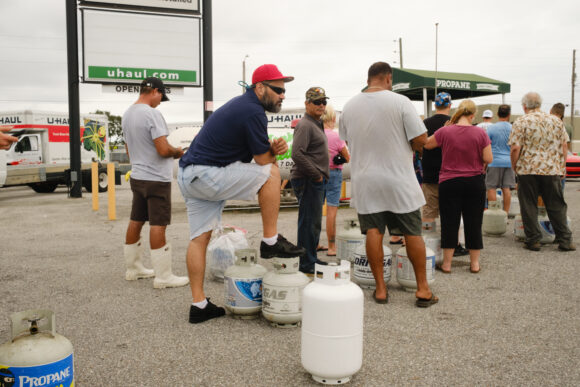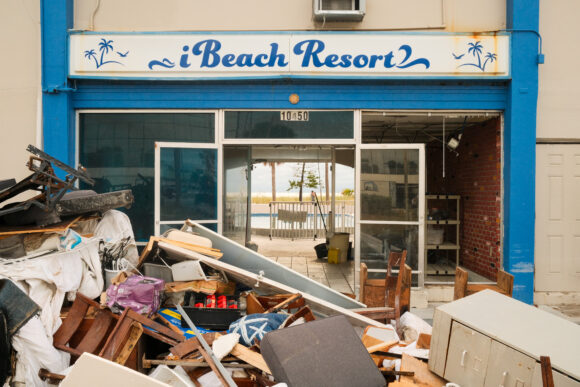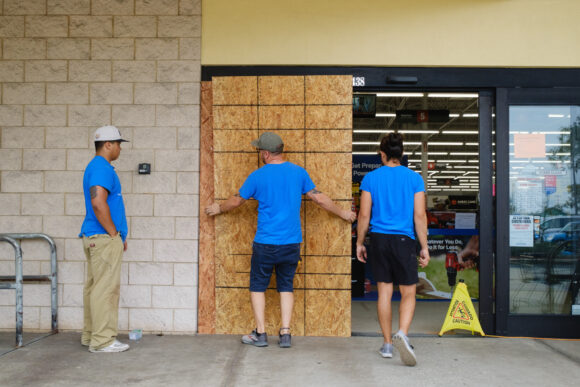Milton is on track to deal a devastating blow to Florida’s vibrant Tampa Bay region, potentially delivering the first direct hit from a hurricane in a century just as residents and businesses were beginning to pick up the pieces from Helene.
The area, which includes the cities of Tampa, St. Petersburg and Clearwater, is home to more than 3 million people, a major U.S. military base, Florida’s largest port, beaches that attract tens of millions of tourists a year and a state university with nearly 50,000 students.
It’s also a hub of business in the Sunshine State. JPMorgan Chase & Co., which has been expanding across Florida, has almost 6,000 employees in Tampa. Other big US banks like Citigroup Inc. also have workforces in the area. And it’s home to corporations ranging from tech company Jabil Inc. to investment firm Raymond James Financial Inc. to restaurant operator Bloomin’ Brands Inc.
Preparations for the storm were in the final stages. Forecasters stressed that Milton is large and likely to have serious impacts no matter where it makes landfall. The Category 4 storm, with maximum sustained winds of 145 miles per hour (233 kilometers per hour), was located about 545 miles southwest of Tampa and moving east-northeast at 12 miles per hour, according to the most recent advisory from the National Hurricane Center.
“Looking at how big this storm is, there’s going to be significant damage in different parts of Florida,” Governor Ron DeSantis said at a news conference in Tallahassee. He urged residents to evacuate if ordered to. “Now is the time to execute your plan.”
The current track of the storm would bring it on land just south of Tampa Bay. Milton’s trajectory could shift further before striking the Florida peninsula.
The Tampa Bay area was hit hard last month by winds, heavy rain and storm surge on the eastern edge of Helene. While the region is far from where Helene came ashore, its Gulf-facing beaches suffered heavy erosion as that storm raced to the northeast. Some residents had to be rescued from their homes as they rapidly filled with floodwater.
Milton will strike just as residents were beginning to clean up.
“The sand dunes are gone along the beaches, so the natural protection we had along the coast is gone,” said Matt Anderson, a meteorologist for the National Weather Service in Tampa. “It’s very unfortunate we had these kind of systems back-to-back.”
For the past week, Claire Elisan has been trying to help the neediest victims of the Helene. The beaches around her home in Largo, across the bay from Tampa, are lined with wrecked homes and apartment buildings, debris and standing floodwater Helene left behind. Elisan said she would likely evacuate but feared others wouldn’t be able to escape.

“You have a lot of folks who can’t get out of their homes, can’t get water,” she said. “There’s a lot of people like that in this community, especially underserved people who are not getting the help they need, even to evacuate. I’m very, very worried.”
Hurricane Milton underwent what the US National Hurricane Center called “explosive” intensification on Monday, as its winds catapulted from Category 1 strength to Category 5 in the span of 24 hours. Milton is being nourished by unusually warm water in the Gulf of Mexico, which also fueled Helene’s rapid growth.
With its high winds and extremely low barometric-pressure readings, Milton at one point ranked among the strongest hurricanes recorded in the Gulf of Mexico in the past five decades, behind Katrina and Rita in 2005 and Allen in 1980, according to hurricane researcher Philip Klotzbach at Colorado State University.
Dave Lackore, chief operating officer at Cyndeo Wealth Partners in St. Petersburg, was born and raised in the city. He said Helene and Milton are among the worst storms that he’s ever seen. He said many areas of the city have become more prone to flooding now than when he was growing up. Cyndeo, which opened during the pandemic in June 2020, is allowing employees to evacuate or work remotely as needed during the storm.
“It’s a rough time,” Lackore said. “We have people affected by Helene that are still trying to recover from that and now we have round two coming in. People are scared about it.”
This is a modal window.The media could not be loaded, either because the server or network failed or because the format is not supported.
Shallow Waters
Situated along the Gulf of Mexico on Florida’s west coast, the Tampa area sits on the edge of a shallow continental shelf that extends about 100 miles offshore, making it particularly vulnerable to storm surge.
Though it has been grazed by numerous tropical systems over the years, the last direct strike on the region came when the Tarpon Springs hurricane swept ashore in October 1921. The Category 4 storm killed eight people and delivered 11 feet of storm surge, destroying docks and ships and upending the local economy.
“That’s beyond our memory,” said Jennifer Collins, a professor of geosciences at the University of South Florida in Tampa.

The surge from Milton is forecast to be higher than in 1921, at as much as 15 feet. The Tampa Bay region is much more heavily populated now, especially along its flood-prone shoreline, and the water is higher than it was a century ago.
“The sea level was about a foot lower than it is today, at a time when we didn’t have the infrastructure and population we have today, and that was still catastrophic,” Collins said.
Tampa International Airport, set along the edge of the bay, suspended operations on Tuesday, affecting 500 arriving and departing flights a day. The forecast storm surge — roughly twice what Helene brought to the area — is likely to flood runways, roadways and some structures, a spokesperson said.
Wind Danger
Barbara Tripp, Tampa’s fire chief, said she’s concerned that debris left behind by Helene could become fuel for further mayhem when Milton arrives.
“We didn’t think we’d be having another hurricane,” said Tripp. “People put everything out on the street, just the whole entire house.”
Tripp said city crews have been working rotating 12-hour shifts, assisted by the Federal Emergency Management Agency and workers from state agencies, to clear away rotting wood and heaps of trash in areas near the water, including around MacDill Air Force Base. Anything that isn’t picked up before Milton makes landfall could become a projectile, causing damage to other structures and posing a threat to people.
“I’m worried about the debris that is not cleaned from Helene,” said Tripp, who has lived in Tampa her entire life. “Where is the wind going to take it?”
Tampa has requested high-water vehicles that can safely navigate floodwaters, as well as extra fire-suppression teams and medical personnel. The medical workers have already arrived, Tripp said, and went to work Monday helping Tampa retirement homes evacuate residents.
Encouraging Evacuation
Emergency-management officials have ordered mandatory evacuations in the most vulnerable areas around Tampa Bay, and are encouraging others outside those areas to consider leaving. Highways were jammed with residents trying to get out of the way of the storm, which is forecast to travel across the state at hurricane strength and emerge back into the Atlantic Ocean.
Large employers said they were urging employees to protect themselves. A Citigroup spokesperson said it was encouraging staff in the storm’s path to work from home. The University of South Florida encouraged students who live on campus to leave and said shelter would be provided for those who need it.
Still, some residents are likely to ride the storm out in their homes despite the risks. Collins, the USF professor, has studied hurricane evacuation patterns for years, and has found that health conditions, financial constraints or personal connections like pets can keep people from leaving.
Lackore, the Cyndeo executive in St. Petersburg, said he and his family are watching the path of the storm and might evacuate to Vero Beach, which is about 165 miles away on Florida’s East Coast — a trip that could be difficult to make if more residents decide to flee the Tampa Bay area. Yet he said his departure would be temporary. Even with the heightened intensity of storms lately, he has no plans to move his firm’s business.
“At this point, we’re here for the long haul,” he said. “The majority of partners were born and raised here, and we have strong ties here.”
For others, there are growing doubts. Normally, Trudy Azarsepandan, a lawyer for a real estate developer, feels pretty good about riding out storms at her home in New Tampa, 20 miles northeast of downtown. The power lines are underground, the area is designed to drain quickly and her house is solidly built.
However, when Milton quickly strengthened to Category 5, she started getting nervous. Azarsepandan, 44, grew up in Miami, where vicious storms were the norm. Her family went without power for two months after Hurricane Andrew in 1992. The prospect of Milton’s fierce winds led her to lean toward evacuating with her husband and 12-year-old son.
They just aren’t sure where to go.
“Some places are just getting so much more water than the infrastructure can handle, getting pounded over and over,” she said. “I don’t know how much we can take.”
Top photo: Workers board up a business ahead of Hurricane Milton’s expected landfall in St. Petersburg, Florida, US, on Monday, Oct. 7, 2024. Milton strengthened into a catastrophic Category 5 hurricane as it bears down on Florida’s west coast, where residents have begun to flee inland in a region still recovering from Helene’s devastation.
Was this article valuable?
Here are more articles you may enjoy.


 Merck Faces Patent Lawsuit Over Easier-to-Use Keytruda
Merck Faces Patent Lawsuit Over Easier-to-Use Keytruda  US Regulator Takes Initial Steps to Boost Self-Driving Cars
US Regulator Takes Initial Steps to Boost Self-Driving Cars  In Fight Over Insurance, Neighbors Crowdsource LA Fire Contamination Data
In Fight Over Insurance, Neighbors Crowdsource LA Fire Contamination Data  FEMA Denies Washington State Disaster Relief From Bomb Cyclone, Governor Says
FEMA Denies Washington State Disaster Relief From Bomb Cyclone, Governor Says 